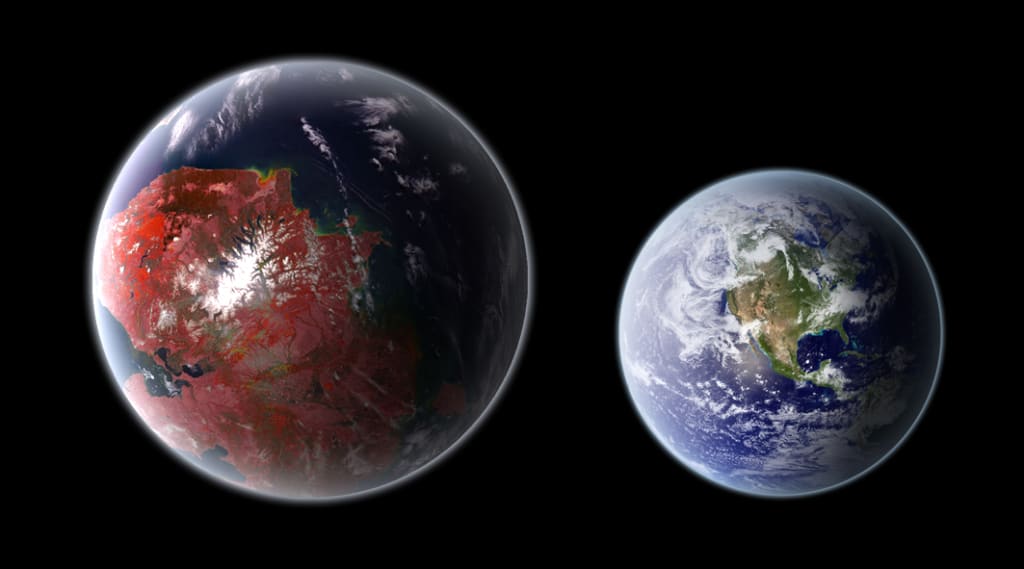The Planet More Habitable Than Earth
We always think that our Planet Earth is the most habitable planet in the universe as it hosts the only living organisms we know to exist. There is, in fact, another competitor that is deemed more habitable than Earth.

This post was created with the support of OpenAI.
Kepler-442b is an exoplanet orbiting around the star Kepler-442, located about 1,120 light-years away from Earth in the constellation Lyra. Discovered by NASA's Kepler spacecraft in 2015, Kepler-442b is a super-Earth, meaning that it has a larger mass and radius than Earth but not as large as the gas giants in our Solar System.
The exoplanet has a radius of approximately 1.3 times that of Earth and a mass of about 2.4 times that of Earth. Kepler-442b orbits its star once every 112 Earth days and receives about two-thirds the amount of sunlight Earth receives from the Sun. This distance puts it within the star's habitable zone, also known as the "Goldilocks zone," where temperatures are just right for liquid water to exist on the planet's surface.
Kepler-442b has a surface temperature estimated to be around -30°C (-22°F), which is cooler than Earth's average temperature of 15°C (59°F). However, the planet's surface temperature is still within the range at which life, as we know it, could exist.
Compared to Earth, Kepler-442b has a few key differences. One of the most significant is its higher mass, which gives the planet a stronger gravitational pull. This means that any potential alien life forms on Kepler-442b would experience stronger gravity than on Earth. The exoplanet's atmosphere is likely thicker than Earth's due to its higher mass, which could lead to higher atmospheric pressure on the surface.
Despite these differences, Kepler-442b is considered to be more habitable than Earth based on a habitability index developed in 2015. The index finds several factors that determine a planet's potential habitability, including its size, mass, distance from its star, and the amount of radiation it receives. Kepler-442b received a habitability score of 0.836, higher than Earth's score of 0.829.
The fact that Kepler-442b is more habitable than Earth raises an interesting question: are there other planets in the universe that are even more habitable than Earth? The answer is yes. While Earth is currently the only known planet in the universe that harbours living organisms, billions of planets in the Milky Way galaxy alone could potentially support some form of life.
What makes a planet habitable? One of the key factors is the planet's distance from its star. If a planet is too close, it will be too hot for liquid water to exist, while if it is too far away, it will be too cold. Other factors determining a planet's habitability include its mass, composition, and atmosphere. For example, a planet with a thick atmosphere would have better protection against harmful cosmic radiation, while a planet with a magnetic field would be better protected against solar wind.
The fact that billions of habitable planets could exist in the universe is a fascinating prospect. It means there could be other life forms, potentially very different from life on Earth. The search for extraterrestrial life is an ongoing endeavour, with scientists using various methods to detect signs of life on other planets.
The discovery of Kepler-442b and other exoplanets like it is a significant step forward in our understanding of the universe and the potential for life beyond Earth. It is also a reminder of the vastness and diversity of the cosmos and the possibility that we may not be alone in the universe.
Kepler-442b is an exoplanet located within its star's habitable zone and considered more habitable than Earth based on a habitability index developed in 2015. Despite its differences from Earth, Kepler-442b's potential habitability raises intriguing questions about the range of conditions that can support life in the universe.
One of the most exciting possibilities is the potential for the discovery of extraterrestrial life. While the existence of life on Kepler-442b remains unknown, the fact that it is located in the habitable zone and has a similar size and mass to Earth suggests that it could be a promising target for future research.
One approach to the search for extraterrestrial life is to look for biosignatures, which are signs of life that can be detected remotely. These could include the presence of certain chemicals in the atmosphere, such as oxygen, methane, or carbon dioxide, which are produced by living organisms on Earth. Other potential biosignatures include the detection of complex organic molecules, which are the building blocks of life, or the presence of liquid water on the planet's surface.
While the search for extraterrestrial life is still in its early stages, recent discoveries such as Kepler-442b provide new insights into the range of planetary conditions that could support life. As our ability to detect and study exoplanets continues to improve, we may be able to answer one of the most fundamental questions in science: are we alone in the universe?
In addition to the search for extraterrestrial life, the discovery of Kepler-442b has implications for our general understanding of the habitability of exoplanets. By studying the characteristics of planets like Kepler-442b, scientists can gain insights into the conditions necessary for life to thrive on other worlds.
One interesting possibility is the existence of "superhabitable" planets, which are even more habitable planets than Earth. These could be worlds with a more stable climate, a thicker atmosphere, or more abundant sources of water and nutrients. While such planets have not yet been discovered, the search for superhabitable worlds is an area of active research.
In conclusion, the discovery of Kepler-442b and other exoplanets like it represents a major milestone in our understanding of the potential for life beyond Earth. While the existence of extraterrestrial life remains unknown, the fact that habitable exoplanets exist suggests that the universe may be teeming with life. As our ability to detect and study exoplanets continues to improve, we may be on the brink of a new era of discovery and understanding that could transform our understanding of our place in the cosmos.
Thank you for taking the time to read our article!
If you enjoyed the content, please consider leaving a '<3' and Subscribe so you don't miss future releases!
If you wish to support us on our mission to provide free, weekly infotainment for you to enjoy, please consider pledging a small donation or leaving a tip - all donations help us to create our work and support us as creators.
If you wish to begin your Vocal journey, join the Vocal+ programme to get more for your work! Earn more per view, withdraw your profits quicker, access Vocal+ Challenges with prizes to be won weekly, and so much more by clicking here!
Let's start a conversation! Leave a comment on what you'd like us to discuss in future articles, or reach out on our Social Media Channels!
You're the reason we can continue doing what we love. We are forever grateful for your support!
About the Creator
People! Just say Something!
Quirky Writing created by Artistic Creativity and the power of AI with the goal of learning something new every day!
Facebook: https://www.facebook.com/PeopleJSS
Twitter: https://twitter.com/PeopleJSS






Comments
There are no comments for this story
Be the first to respond and start the conversation.